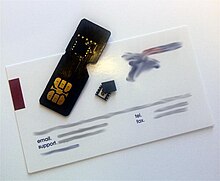eSIM
The eSIM is a procedure standardized by the GSM Association for the secure embedding of subscriber information in a special module of a mobile terminal for telecommunications. It should replace the classic SIM card in the future. The acronym "eSIM" is interpreted as an abbreviation for embedded subscriber identity module ( English for "built-in subscriber identity module " ).
The main difference between the eSIM and the already established, classic SIM card is the way it is provided by the mobile network operator . If these were either sold in a shop or sent by post in the past, a customer can use the eSIM to become a customer of a mobile phone provider online at any time and use his mobile phone or other device immediately, if the provider supports this. Once loaded into the mobile device, there are no major differences to the use of a physical SIM card. For manufacturers, the SIM card mounting mechanism can be completely dispensed with in the future. The eSIM is electrically compatible with 2FF and 3FF cards , it uses the SON-8 format and is designed for M2M ( machine-to-machine ) applications.
In Germany, the eSIM is supported and offered by the network operators Telekom, Vodafone and Telefónica Deutschland. To activate an eSIM in a device, however, an existing internet connection (e.g. via WLAN) is required.
In Switzerland, the eSIM is supported and offered by Swisscom, Sunrise and Salt.
history
The first version of the eSIM architecture specification was published on December 23, 2015.
The first device that could be equipped with a subscriber ID via the eSIM standard was the Samsung Gear S2 smartwatch in its 3G version from the manufacturer Samsung . It was announced by the manufacturer in the run-up to IFA 2015 and presented at the trade fair.
In 2018, Google equipped the Pixel 3 3XL models and Apple the iPhone XS , XS Max and XR models with support for eSIM. While Android smartphones have been dual SIM capable for many years , iPhone models are now also able to operate more than one cellular connection in parallel for the first time.
standardization
The eSIM standard is based on several procedures and specifications issued by the GSM Association. In detail these are:
- SGP.21 eSIM Architecture Specification - covers the higher-level architecture for providing eSIM
- SGP.22 eSIM Technical Specifications - deals with the technical specifications to be complied with
- SGP.23 eSIM Test Specifications - handles the test cases to be used to check an implementation
- SGP.24 Compliance process - deals with the processes to be followed in order to be able to declare a product as "eSIM-capable"
- SGP.25 eUICC for Consumer Device Protection Profile V1.0 - describes the security requirements for the eSIM profile in the form of an object of evaluation
Web links
Individual evidence
- ↑ eSIM Whitepaper - Section "How it Works" . GSM Association. Retrieved December 25, 2018.
- ↑ GSMA Embedded SIM Specification Remote SIM Provisioning for M2M . GSM Association. Retrieved December 28, 2018.
- ↑ eSIM | Telecom help. Retrieved October 3, 2018 .
- ↑ Help | Everything about eSIM. Retrieved October 3, 2018 .
- ↑ eSIM information from o2: Everything about "embedded SIM". Retrieved November 10, 2018 .
- ↑ eSIM will replace the SIM card. Accessed December 30, 2019 .
- ↑ Sunrise eSIM. Accessed December 30, 2019 .
- ↑ Salt eSIM. Accessed December 30, 2019 .
- ↑ eSIM specifications . GSM Association. Retrieved December 25, 2018.
- ↑ Announcement Smartwatch Gear S2 with 3G . teltarif.de. Retrieved December 25, 2018.
- ↑ Apple support document for the use of dual SIM . Apple Inc. Retrieved December 25, 2018.
